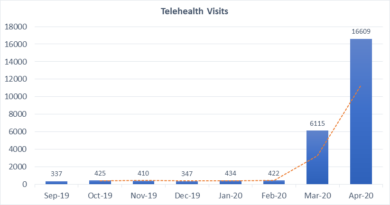Shaping Telemedicine Strategy through Defining Measures of Success
By Meagan F. Moyer, MPH, RDN, LD and Gregory J. Esper, MD, MBA, Emory Healthcare
Why Measure Outcomes of Success?
The American Telemedicine Association defines telemedicine (and its closely associated term, telehealth) as the “use of medical information exchanged from one site to another via electronic communications to improve patients’ health status”. Furthermore, telemedicine is defined not as a separate medical specialty, but as a product or service that is part of a larger investment by a healthcare system to deliver clinical care. As with any investment by an organization, programs utilizing telemedicine must track outcome measures so that care providers can focus their efforts on either expanding those programs or defining different care models to provide healthcare for their populations. Results-oriented efforts can lead to long-term success and growth of telemedicine programs. This article outlines the measures that Emory Healthcare’s telemedicine team uses to define programmatic strategies and assess success.

Emory Healthcare’s central telemedicine operations team (EHC TOT) does not deliver telemedicine services directly to patients, but rather serves as a resource to clinical departments who then provide care via telemedicine. As internal consultants, EHC TOT assists in the planning, implementation and growth of telemedicine programs. Before EHC TOT can assist a clinical team in pursuing telehealth as a care delivery model, the group must define how the program will contribute to EHC’s annual operating plan goals, and which outcome measures will be continually assessed to ensure success in achieving those goals.
Emory Healthcare’s Telemedicine Outcome Measures of Success
Certain outcomes can be weighted more than others when considering projects to purse based on the organization’s priorities and overall strategy. Examples, notes and descriptions are provided to give context and to help generate ideas for other healthcare organizations starting telehealth programs. Keep in mind that one telemedicine project can accomplish several measures of success.
- Internal Cost Reduction: current/future cost avoidance of internal direct or indirect healthcare costs.
- Example: video monitoring of in-hospital patients for epilepsy/seizure monitoring or fall risk can reduce the need for in-room sitter recurring costs
- Note: Be sure to assess associated fixed and variable costs with the finance team prior to implementation of the project to measure change.
- External (Payor) Cost Reduction and defined population management
- Example: Remote monitoring of diabetes patients’ daily blood glucose to improve overall health outcomes by reducing short-term complications (diabetic ketoacidosis) and long-term complications (heart, brain, kidney, eye, and nerve damage).
- Note: this requires extensive cooperation with the organization’s population management team to generate lists of appropriate patients to follow so that quality and cost metrics can be appropriately tracked.
- Revenue Generation: consumer-driven/cash-payment for access to healthcare team
- Example: give patients the ability to access care with their providers from the comfort of their home, though this is not typically reimbursed by government or commercial insurance companies to date.
- Note: Revenue and reimbursement will vary state by state based on differing telehealth policies. Be sure to know your state’s policies before planning a revenue-generating project. Also, define how practitioners will deploy this, either in conjunction with their in-person clinic schedule or as a telemedicine-only schedule.
- Internal/External Healthcare Team Access: decrease the delay between clinical need and receipt of services
- Example: Provide store-and-forward teledermatology consultations to assist primary care doctors in defining whether skin lesions can be managed with or without an in-person consultation with a dermatologist (e.g. defining a non-threatening rash vs. need for biopsy for possible skin cancer).
- Note: in absence of appropriate payment models, organizations must define how “credit” to teams providing the increased access will be given.
- Provider Shortage Relief: internal and external extension of providers of general and specialty medical care
- Example: Provide rural consultations for complex medical case treatment management, including telestroke, telepsychiatry, telenephrology, and critical care services (electronic intensive care unit).
- Note: this requires extensive contracting arrangements with outside institutions, and legal, compliance, and credentialing teams are required for ultimate deployment.
- Coordination/Integration of Care: cross-system communication and assimilation of resources to improve patient outcomes
- Example: Provide cognitive behavioral therapy for patients suffering from post-traumatic stress.
- Note: Consider utilizing allied healthcare providers including psychologists, registered nurses (RNs), licensed clinical social workers, physical therapists, occupational therapists, registered dietitian nutritionists and speech-language pathologists as well as advanced practice providers (APPs) to deploy services.
- Operational Flow: treat patients in a more efficient manner while reducing waste
- Example: Use video-based triage with healthcare providers in the Emergency Department for low acuity cases
- Note: For this type of project, typical metrics are emergency department length of stay, doctor, APP, and RN staffing ratios per patient, and patient/family satisfaction metrics.
- Quality and Safety: improving the quality of medical care and safety of patients, their families and staff members
- Example: video monitoring of health care professionals donning and doffing personal protective equipment in serious communicable diseases units (e.g. units in which patients with Ebola virus receive care), which is essential to protect health care workers and limit the spread of disease.
- Note: improving quality and safety may require extensive investments for which ROI may be difficult to track by finance. Explicit discussion of how these metrics will be tracked on the yearly organizational balanced scorecard is recommended.
Shaping Your Own Strategy and Measures of Success
Before healthcare systems create their telemedicine strategy, healthcare system executives and key leaders should be approached to articulate what strategy area(s) matter most; then, the telemedicine team can prioritize the projects that will meet these outcomes. This will not only help with the adoption and growth of the telemedicine program but also allow leaders to remain engaged in the work. Keep in mind that these areas will likely change from year to year based on overall organizational needs and priorities; therefore, it is important to continually ask for strategic clarity. It is recommended to set priorities once per year (ideally prior to the new fiscal year) while remaining open to adjustment when a major organizational event occurs that may impact or influence the work. This may include mergers, acquisitions, or partnerships with other healthcare systems or organizations. State and national telehealth policy changes may also influence your strategy as changes to reimbursement models, practitioner licensure, and geographic requirements are made.
In addition to engaging leaders within our organization, EHC TOT also involves a representative from the EHC Patient and Family Advisory Council when prioritizing projects and strategies to pursue. This ensures that patients are given a voice in decision-making, especially when the project is consumer-facing and therefore will require patient and family/care-giver adoption. It is therefore recommended for organizations to engage a similar committee. If one does not exist, consider creating patient and family focus groups with the intended audience of the telemedicine program for valuable feedback and points of consideration.
Conclusion and Next Steps
Telemedicine offers important opportunities for healthcare organizations to expand care and access for patients and families and to improve the joy of practice for clinicians. Because human and financial resource investments are considerable, this must be done in conjunction with the overarching strategic plan of the healthcare organization and with the support of the chief executive officer and other key leaders. In order to maintain this support and continued reinvestment, the groups responsible for telemedicine care models should always aggressively track metrics that are visible to decision makers in the organization. As telemedicine programs expand, continued sharing of best practices is critical to the long-term success of these care models, and refinement of metric tracking is critical. This constant attention will ensure telemedicine’s growing success during the shift from volume-based to value-based healthcare.



